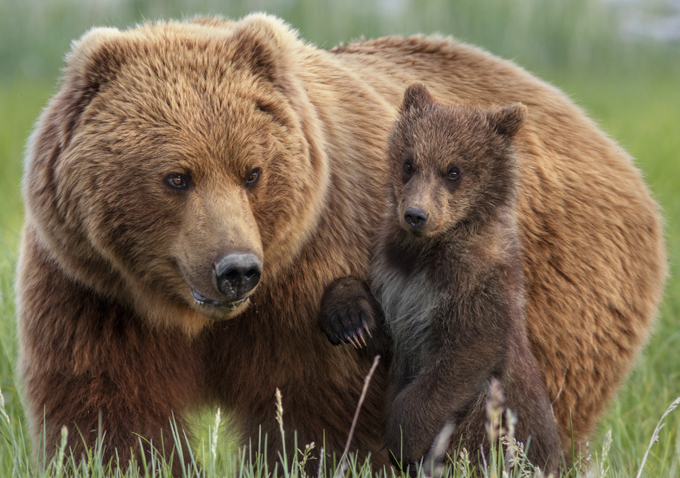
It seems fitting that Disney, a studio that has had such a solidly illustrious history with anthropomorphic bears (between Winnie the Pooh, the Country Bears at Disneyland and Br’er Bear from “Song of the South,” all the way up to the magical bears that populated Pixar‘s Oscar-winning “Brave“), would circle back and focus an entire film on the actual animals. This year’s Disneynature documentary, “Bears,” features honest-to-goodness Alaskan bears, the kind that wake up from a snowy den and spend all year gathering food for the next winter. What’s amazing about the documentary, though, is that it’s oftentimes just as engaging as the Disney bears that play in jug bands or crave ooey-gooey honey.
Every Disneynature movie has a loose kind of narrative, usually about a familial unit and some kind of adverse condition. But “Bears” is better suited to a traditional narrative than most, given that the bears’ life cycle is perfectly engineered for an 80-minute run time. In the first year of a newborn bear’s life, it must make a treacherous journey with its mother from the top of snow-peaked mountains down to the grassy Alaskan plains, where all sorts of nasty things want to eat it, and then back up to the mountaintop for another hibernation. Since they are only out of the cave for half the year, it makes for a condensed six months, both biologically and in dramatic terms, especially since if the mother bear can’t eat enough food in that period, then the babies will starve during hibernation.

Heavy shit for a children’s movie, even when the voice of John C. Reilly, as the movie’s trustworthy narrator, coos horrifying, ripped-from-nature statistics like, “Almost half of all bear cubs don’t survive their first year.” As the documentary reinstates, time and time again, for these young bears danger is literally at every turn—from avalanches that cascade down the mountain, to older, mangier bears who are likely to cannibalize the cubs if they get hungry enough, to the odd grey wolf prowling the meadow.
There are moments in “Bears” that are quite exciting, and it’s a testament to Alastair Fothergill and Keith Scholey, the British documentarians also responsible for Disneynature’s “Chimpanzee” and “African Cats,” that there’s an air of queasy unpredictability. There’s a moment when one of the two cubs in the movie, Scout, falls asleep after traveling with his sister and their mother out into the ocean. The tide starts coming in, and his sister and mother have left him behind. It’s a moment of suspense that turns into sheer panic, since you trust the filmmakers enough to not interfere with the laws of nature. It’s wild and unpredictable and a total testament to the fearlessness of the filmmakers and the wildness of nature. The fact that the possibility of a bear drowning in a Disney nature documentary even cropped up is pretty spectacular, in a perverse kind of way. (Don’t worry you ghouls, Scout doesn’t drown.)

“Bears,” shot at the Katmai National Park in Alaska, a habitat almost exclusively populated by bears until relatively recently, has, like all Disneynature films, the handsome squareness of an EPCOT movie. It’s hard not to get taken aback by the epic grandeur of Alaska with its rugged topography and general rawness. After watching “Bears” you start to understand why everyone with a criminal record heads to Alaska. It seems like a very easy place to get very lost.
Reilly, for his part, does a better job than most narrators at keeping things lively and entertaining. He was very clearly riffing on the script that was provided for him. And while it was occasionally hard to listen to a mostly straight-faced Reilly talk about the biological cycle of bears without thinking of his gonzo Adult Swim alter ego Dr. Steve Brule (for your bears!), that same underlying goofiness made lines like “Suddenly everyone is very itchy,” come across not as some platitude but as a distinctly human observation. (Supposedly he had a hand in shaping the film’s script once he got into the booth.) When Reilly starts to speak as the bears, it’s an endearing moment, and reminiscent of his voice work in Disney‘s “Wreck-It Ralph;” a big galoot who just wants love. And fish.

The single-minded focus of “Bears” is both its biggest attribute and, arguably, largest problem. Because the movie is so dialed into the world of bears—and not even all bears, but this small cluster of bears—much of the rest of the story remains untold. Maybe it is a fool’s errand to try and encapsulate any more of the struggle into the aforementioned 80-minute run time, but it does leave lingering questions. There are small things that nag. Where, for example, is the father bear in this family unit? Did he die? Do all female bears raise their cubs independently? (Listen, I’m no bear expert.) But then there are other, larger questions like how is this delicate ecosystem being affected by the oil and natural gas operations in Alaska (like that godforsaken pipeline)? Are these bears being protected to some degree? Or are they about to face an even bigger problem then finding enough salmon to eat?
But a cuddly Disneynature documentary called “Bears” is probably not the place to get into these issues. Instead, it’s where you go if you want to see an entertaining, beautifully shot, oddly moving story of a mama bear and her two cubs who, like most of Alaska (and America), is just trying to survive, driven by primordial instinct and loving impulses. Walt Disney himself might have been accused of popularizing the anthropomorphic animal, both in his cartoons and the nature documentaries that he invented, but what research is showing us, along with movies like “Bears,” is that Disney didn’t have to give them personality traits; nature already took care of it. [B+]

